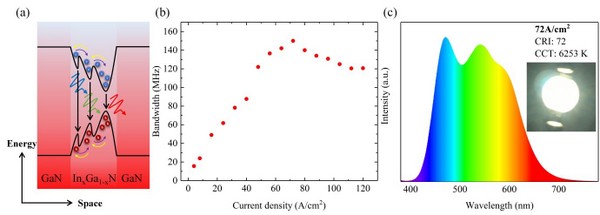Visible light communication (VLC) is a wireless method that enables high-speed transmission of data with visible light. This data is transmitted by modulating the intensity of light given off by a light source. The signal is received by a photodiode device that transforms the data into forms that are readable and readily-consumed by end users. It is widely expected that VLC systems and their extension to fully networked, bi-directional multiuser wireless systems referred to as LiFi will play a key part in 5G-and-beyond connectivity, especially for indoor environments.
Compared with traditional communication technology, VLC shows many outstanding advantages: 1. In the form of increasingly tight wireless spectrum resources, the visible light band is still a blank spectrum and can be used without authorization. At the same time, there is no electromagnetic interference problem, and it can be used in radio-shielded places; 2. VLC technology transmits information by changing the intensity of light. Light will not cause discomfort to human eyes under high-speed changes, and there is no harm of electromagnetic wave radiation; 3. Light emitting diode (LED) has high-speed modulation characteristics, so it is very suitable for VLC technology, in the original lighting and display functions, it can also add communication function. The popularity of LED will also bring convenience to the application of VLC. Although there have been many related reports on LED-based VLC, most of them use blue light sources, which will be very limited for practical applications. Due to the widespread popularity of LED lighting, the white light source is the ideal light source for VLC. Therefore, it is important to develop a white light source with high modulation bandwidth and lighting performance.
At present, the widely adopted approach for lighting-oriented white LEDs (WLEDs) is to utilize the blue LED to excite the yellow phosphors (YAG:Ce). However, the overall bandwidth of above mentioned phosphor converted WLED is only few MHz, majorly limited by the following factors: long lifetime of YAG: Ce phosphor and slow stokes transfer process; resistance-capacitance (RC) time delay of the broad area WLEDs; quantum-confined Stark effect (QCSE) of the InGaN/GaN quantum wells (QWs) from intrinsic piezoelectric polarization filed. Besides, YAG:Ce phosphor exhibits some disadvantages of wide emission spectrum, absent of red spectrum component, large particles size (~10 μm), color conversion and phosphors efficiency droop.
Some approaches have proposed to overcome the above-mentioned limits. Novel color conversion materials are developed, such as conjure polymer, quantum dots (QDs), carbon dots. Although some novel color conversion material are proposed to replace phosphors, their stability is poor and the fluorescence lifetime of color conversion material is still longer than the carrier recombination lifetime of LED chips, resulting in the fact that color conversion material always limit the bandwidth of WLEDs. Micro-LED is usually used to reduce the RC time delay and release the polarization field. However, too small chip is not suitable for lighting applications. Especially what should be noted is that the reports on VLC oriented Micro-LEDs are operated at substantially high current density, normally over kA/cm2, which is obviously not suitable for real application due to severe efficiency droop of Micro-LEDs and heat dissipation issue. Epitaxial grow on semi-polar, non-polar plane is feasible yet the growth process is complicate and needs to improve the material quality further. Structures such as resonant cavity LEDs (RC LEDs), and photonic crystal LEDs (PhC LEDs) have been studied and the design and fabrication is also complicate. Red, green and blue tri-color LED chips together can achieve higher modulation bandwidth, yet the modulation is complex for communication.
The research group led by Prof. Liancheng Wang from Central South University and Prof. Xiaoyan Yi from Institute of Semiconductors, Chinese Academy of Sciences demonstrated a phosphor-free single chip WLED with high modulation bandwidth and moderate color rendering index (CRI) at low current density. The research results are published in Photonics Research, Vol. 8, Issue 7, 2020 (Rongqiao Wan, Xiang Gao, Liancheng Wang, et al. Phosphor-free single chip GaN-based white light emitting diodes with a moderate color rendering index and significantly enhanced communications bandwidth[J]. Photonics Research, 2020, 8(7): 07001110). The material was provided by Panpan Li, from Yangzhou Zhongke Semiconductor Lighting Company.
The phosphor-free broadband spectrum single chip WLED by employing self-assembled InGaN QDs structure, which exhibits tunable correlated color temperature (CCT, from 1600 K to 6000 K), a maximum CRI of 75 and large -3 dB modulation bandwidth of 150 MHz at low current density of 72 A/cm2. Compared to traditional InGaN/GaN QWs structures, the self-assembled QDs can significantly reduce the built-in piezoelectric polarization field, leading to an alleviation of QCSE. This phosphor-free structure can completely get rid of the restriction of phosphor on the bandwidth of WLED Furthermore, the quasi-three-dimensional confinement of carriers in the InGaN/GaN QDs inhibits non-radiative recombination due to localization effect. Consequently, the InGaN QDs based single chip WLEDs shows potential in meeting both lighting and fast VLC applications.
This work presented the high modulation bandwidth and moderate lighting performance of the single chip WLEDs at low current density. Moreover, the application of these single chip WLEDs in VLC has also been demonstrated. Future work will focus on further optimizing the growth conditions of InGaN QDs to optimize the composition of the emission spectrum. In addition, the luminous efficiency also needs to be improved, in order to improve the signal-to-noise ratio and reduce the bit error rate.

(a) Schematic illustration the carrier recombination mechanism of InGaN QDs based single chip WLED; (b) The bandwidth of single chip WLED versus injection current density; (c) EL spectra of the single chip WLED at 72 A/cm2 (90 mA), the corresponding EL image in the inset.


